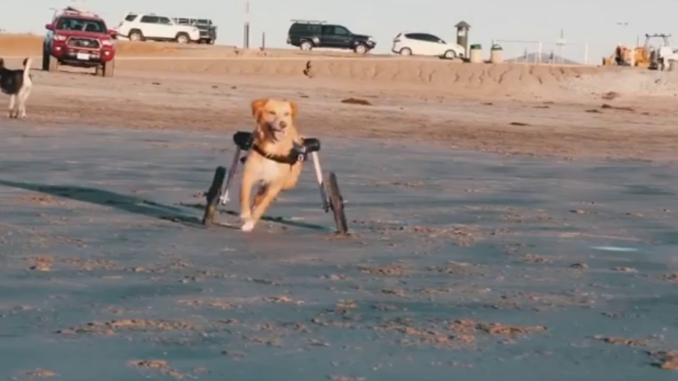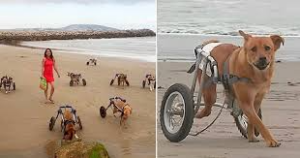
Introduction: The Magic of a Day at the Beach with Disabled Dogs
Sometimes, the simplest of moments can bring the greatest joys, especially when they involve deep love and compassion. Imagine a woman taking her disabled dogs to the beach for a day of fun, freedom, and fresh air. It’s a story that touches the heart, reminding us of the power of kindness and the bond we share with our pets.
In this article, we’ll dive into the emotional journey of a woman who made sure her beloved disabled dogs experienced the joy of the beach, despite their challenges. The beach became not just a destination, but a place where love, joy, and healing met.
Why Taking Disabled Dogs to the Beach is a Heartfelt Act of Love
For many dog owners, their pets are family. When a dog faces physical challenges, it’s only natural to want to make sure they continue to live a full and happy life. For disabled dogs, a trip to the beach might seem like a far-off dream, but with determination and care, that dream can become a reality.
The Importance of Giving Disabled Dogs New Experiences
Disabled dogs may struggle with mobility or face health challenges, but that doesn’t mean they can’t experience the world around them. A trip to the beach is more than just a getaway—it’s an opportunity for a disabled dog to explore, feel the sand under their paws, and enjoy a new environment. For these dogs, every moment of joy is a victory.
Creating Special Memories with Disabled Dogs
Taking your disabled dogs to the beach isn’t just about giving them an enjoyable day—it’s about creating memories that will last a lifetime. Whether they’re dipping their paws in the water, sniffing the fresh air, or simply lying in the sun, the experience will stay with them (and you) forever. It’s these moments that define the bond between a woman and her dogs.
Preparing for the Perfect Beach Day for Disabled Dogs
If you’re considering taking your disabled dogs to the beach, planning ahead is key. It’s not just about showing up—it’s about making sure your furry companions are safe, comfortable, and happy.
1. Consult with a Veterinarian Before the Trip
Before embarking on any adventures with a disabled dog, it’s important to check with a veterinarian. Your vet can give you advice on whether your dog is physically capable of making the trip and offer tips on how to make the outing more enjoyable for them.
2. Choose the Right Beach
Not all beaches are created equal when it comes to accessibility. Some beaches may have uneven terrain, which can be difficult for a disabled dog to navigate. Look for dog-friendly beaches with flat, even ground or accessible areas, so your dog can move around comfortably.
3. Bring the Necessary Equipment
Depending on your dog’s disability, you may need to bring special equipment to make the trip more enjoyable. Consider bringing:
- A dog wheelchair: If your dog has mobility issues, a wheelchair can help them move freely and enjoy the day.
- Portable ramps: These can be helpful for getting your dog in and out of the car or onto a beach deck.
- Comfortable bedding or towels: This will allow your dog to rest on the sand without discomfort.
- Sun protection: Dogs with limited mobility may have trouble finding shade, so bring an umbrella or beach tent to keep them cool.
4. Plan for a Relaxed Pace
The key to a successful beach trip with a disabled dog is not rushing. Allow your dog to explore at their own pace and rest when they need to. Let the day unfold naturally, with lots of opportunities for breaks and relaxation.
The Special Bond Between a Woman and Her Disabled Dogs
The bond between a woman and her disabled dogs is truly special. It’s built on years of care, empathy, and a deep understanding of the dog’s needs. For a woman to take her disabled dogs to the beach, it’s not just a gesture of love—it’s an expression of devotion.
Nurturing the Emotional Connection
Taking a disabled dog to the beach represents the strength of the emotional connection shared between the owner and their dog. For many people, their dogs provide companionship, comfort, and unconditional love. This trip is a way to show appreciation for that love by giving the dog an experience they might not have had otherwise.
Overcoming Challenges Together
A woman who takes her disabled dogs to the beach faces challenges every day—whether it’s managing medical needs, ensuring their comfort, or making adjustments to everyday routines. But moments like a beach outing show that despite the challenges, there’s always room for joy. Every little victory, whether it’s the dog stepping onto the sand or the joy of watching them sniff the ocean air, is a reminder of the strength in their bond.

The Impact of the Beach on Disabled Dogs
For disabled dogs, being on the beach can have both physical and emotional benefits. Here’s how a day at the beach can impact these special dogs:
1. Physical Stimulation and Healing
The soft, cool sand of the beach can provide a gentle surface for disabled dogs to move around on. For dogs with joint issues or limited mobility, the beach provides a space to stretch and exercise without the hard, unforgiving surfaces of city streets or the home. Even if the dog isn’t running or playing, simply walking on the sand can offer physical stimulation that improves circulation and muscle tone.
2. Mental and Emotional Enrichment
New environments, smells, and sounds can help engage a disabled dog’s senses in ways that are beneficial to their overall mental health. The fresh air, the sound of waves crashing, and the variety of scents from the ocean and surrounding nature can offer significant enrichment, helping the dog feel more alert, happier, and less stressed.
3. Boosting Confidence and Happiness
For disabled dogs, simply being outside and engaging in new experiences can significantly boost their confidence. Seeing their owner interact with them, celebrating their moments of exploration, can also foster a sense of accomplishment. The beach outing helps to break the routine and can provide a much-needed emotional lift.
Conclusion: A Day of Joy and Freedom for Disabled Dogs
The heartwarming moment when a woman takes her disabled dogs to the beach is more than just a day out. It’s a testament to the power of love, dedication, and the deep bond shared between humans and their pets. Despite their disabilities, these dogs can experience joy, freedom, and happiness in ways that matter deeply.
As pet owners, we can all learn from the compassion shown in these moments. Every dog, regardless of their abilities, deserves to live a full life—one filled with love, adventure, and meaningful experiences. So, if you have a disabled dog, consider taking them on their own special adventure. Who knows? A trip to the beach might be just what they need.
FAQs About Taking Disabled Dogs to the Beach
1. How can I tell if my disabled dog is ready for a beach trip? The best way to determine if your disabled dog is ready for a beach trip is to consult with your vet. If your dog’s condition is stable, and they enjoy short outings, they may be ready for the beach. Always consider your dog’s mobility, stamina, and comfort levels.
2. Can all disabled dogs enjoy a day at the beach? Not all disabled dogs are physically able to enjoy a day at the beach, but many can, especially if they have the right support (like a wheelchair or ramps). Each dog is different, so assess their unique needs.
3. What are the best types of beaches for disabled dogs? Look for beaches that have smooth, flat terrain or accessible pathways. Some beaches even have special accommodations for disabled pets, such as ramps and dog-friendly areas.
4. What should I bring for my disabled dog to the beach? You’ll want to bring items such as a dog wheelchair, ramps, towels, water, and sun protection. Consider your dog’s specific needs and bring anything that will make them more comfortable.
5. How do I ensure my disabled dog stays safe at the beach? Monitor your dog closely at the beach, keep them hydrated, and make sure they have a shaded area to rest. Avoid areas with rough terrain or strong waves, as these could pose risks for your dog’s safety. Always keep a close eye on them during the trip.
